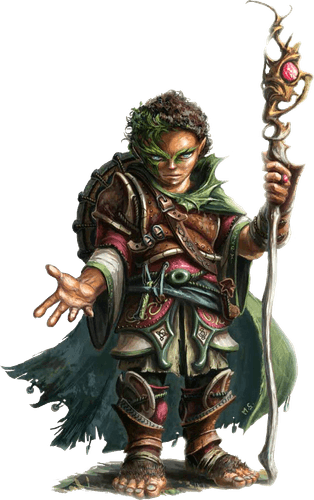
The comforts of home are the goals of most hin’ lives: a place to settle in peace and quiet, far from marauding creatures and clashing armies; a blazing fire and a generous meal; fine drink and fine conversation. Though some hin live out their days in remote agricultural communities, others form nomadic bands that travel constantly, lured by the open road and the wide horizon to discover the wonders of new lands and peoples. But even these wanderers love peace, food, hearth, and home, though home might be a wagon jostling along a dirt road or a raft floating downriver.
Small and Practical
The diminutive hin survive in a world full of larger creatures by avoiding notice or, barring that, avoiding offense. Hin appear relatively harmless and so have managed to survive for centuries in the shadow of empires and on the edges of wars and political strife. They are inclined to be stout, weighing between 40 and 45 pounds.
Hin’s skin ranges from tan to pale with a ruddy cast, and their hair is usually brown or sandy brown and wavy. They have brown or hazel eyes. Hin men often sport long sideburns, but beards are rare among them and mustaches even more so. They like to wear simple, comfortable, and practical clothes, favoring bright colors.
Hin practicality extends beyond their clothing. They’re concerned with basic needs and simple pleasures and have little use for ostentation. Even the wealthiest of hin keep their treasures locked in a cellar rather than on display for all to see. They have a knack for finding the most straightforward solution to a problem, and have little patience for dithering.
Kind and Curious
Hin are an affable and cheerful people. They cherish the bonds of family and friendship as well as the comforts of hearth and home, harboring few dreams of gold or glory. Even adventurers among them usually venture into the world for reasons of community, friendship, wanderlust, or curiosity. They love discovering new things, even simple things, such as an exotic food or an unfamiliar style of clothing.
Hin are easily moved to pity and hate to see any living thing suffer. They are generous, happily sharing what they have even in lean times.
Blend into the Crowd
Hin are adept at fitting into a community of humans, dwarves, or elves, making themselves valuable and welcome. The combination of their inherent stealth and their unassuming nature helps hin to avoid unwanted attention.
Hin work readily with others, and they are loyal to their friends, whether hin or otherwise. They can display remarkable ferocity when their friends, families, or communities are threatened.
Pastoral Pleasantries
Most hin live in small, peaceful communities with large farms and well-kept groves. They rarely build kingdoms of their own or even hold much land beyond their quiet shires. They typically don’t recognize any sort of hin nobility or royalty, instead looking to family elders to guide them. Families preserve their traditional ways despite the rise and fall of empires.
Many hin live among other species, where the hin’ hard work and loyal outlook offer them abundant rewards and creature comforts. Some hin communities travel as a way of life, driving wagons or guiding boats from place to place and maintaining no permanent home.
Exploring Opportunities
Hin usually set out on the adventurer’s path to defend their communities, support their friends, or explore a wide and wonder-filled world. For them, adventuring is less a career than an opportunity or sometimes a necessity.
Hin Names
A hin has a given name, a family name, and possibly a nickname. Family names are often nicknames that stuck so tenaciously they have been passed down through the generations.
Male Names: Alton, Ander, Cade, Corrin, Eldon, Errich, Finnan, Garret, Lindal, Lyle, Merric, Milo, Osborn, Perrin, Reed, Roscoe, Wellby
Female Names: Andry, Bree, Callie, Cora, Euphemia, Jillian, Kithri, Lavinia, Lidda, Merla, Nedda, Paela, Portia, Seraphina, Shaena, Trym, Vani, Verna
Family Names: Brushgather, Goodbarrel, Greenbottle, High-hill, Hilltopple, Leagallow, Tealeaf, Thorngage, Tosscobble, Underbough
Other names
Some other species refer to hin by other names.
- Halfling is a derogatory term for hin that is derived from the fact that hun are about half the size of a human, but otherwise very similar in appearance. It implies that hin are half of normal, half-human, or not worthy of being considered a full being.
- Hin are sometimes referred to as the good folk or quick folk in other languages.
- Hin are sometimes referred to as the sly folk in other languages, which is derogatory.
Traits
Your hin character has a number of traits in common with all other hin.
Creature type. You are a Humanoid.
Health. Your health increases by 6.
Size. Your size is Small, you stand between 80 centimeters and 120 centimeters tall, and you require half as much food and water as a Medium character.
Speed. Your base walking speed is 4 meters.
Age. A hin reaches adulthood at the age of 20 and generally lives into the middle of their second century.
Lucky. When you roll a 2, 3, or 4 on a skill check or a saving throw you can reroll the dice.
Brave. You have advantage on saving throws against being frightened.
Nimbleness. You can move through the space of any creature that is of a size larger than yours and you have advantage on skill checks to avoid or escape a grapple.
Naturally Stealthy. You can attempt to hide even when you are obscured only by a creature that is at least one size larger than you.
Skilled. You are capable with the Deception, Nimbleness, or Stealth skill.
Languages. You are proficient with Linguistics (Common) and Linguistics (Hin).